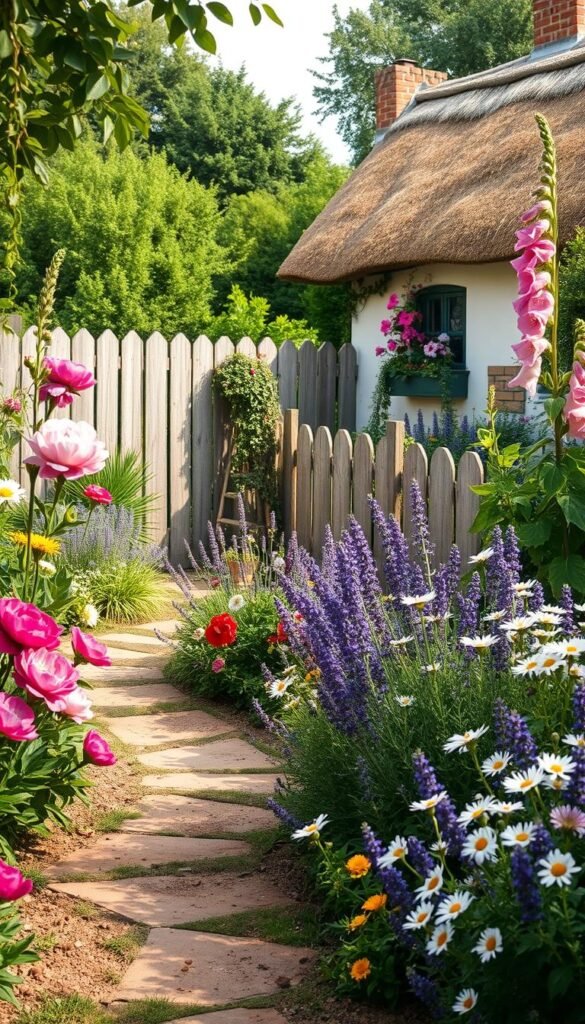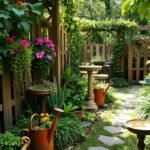Imagine stepping into a space where vibrant blooms spill over weathered stone paths, and fragrant herbs mingle with climbing roses. This is the essence of a cottage garden—a timeless style that blends beauty with practicality. Unlike rigid formal landscapes, these designs thrive on spontaneity, celebrating nature’s imperfections while offering a feast for the senses.
At their core, these spaces prioritize organic growth and personal expression. You’ll find edible plants like lavender or thyme nestled among colorful perennials, creating a living tapestry that changes with the seasons. Even compact yards can burst with life by layering plants vertically and choosing varieties that bloom in succession.
The magic lies in embracing nature’s rhythm. Let self-seeding flowers like poppies or cosmos wander freely, adding whimsy to your layout. For inspiration on balancing wild beauty with structure, explore our guide to design principles for outdoor spaces.
What makes this approach special? Your garden becomes a reflection of your creativity. There’s no rulebook—only a philosophy of working with the land, not against it. Whether you’re reviving heirloom varieties or crafting cozy seating nooks, every choice adds to the story of your unique sanctuary.
Embrace the Cottage Garden Ethos
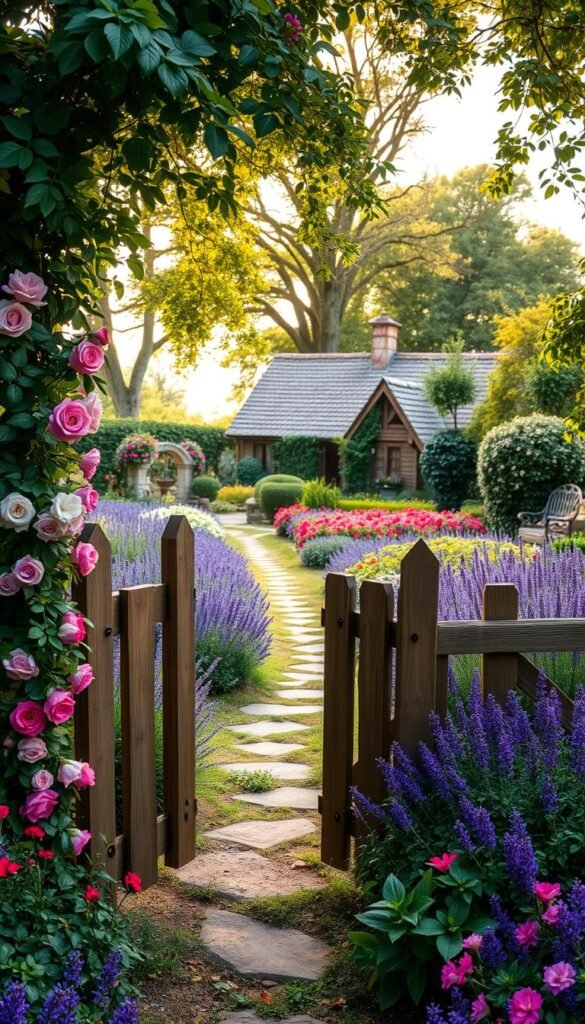
Think of a landscape that evolves with each season, guided by patience rather than perfection. This mindset defines the cottage garden approach—where nature writes the rules, and your role is to collaborate rather than control.
| Philosophy | Cottage Garden | Formal Garden |
|---|---|---|
| Growth Style | Self-seeding plants ramble freely | Pruned geometric shapes |
| Maintenance | ‘Slow gardening’ with seasonal surprises | Weekly trimming schedules |
| Aesthetic | Imperfectly charming | Manicured precision |
Adopting this ethos means welcoming foxgloves that pop up unexpectedly or clematis vines that twist through fence cracks. These happy accidents create layers of texture, blending edible herbs with romantic blooms like old-fashioned roses.
Your space becomes a sanctuary for bees, butterflies, and birds when you prioritize native plants. Instead of pesticides, let ladybugs handle aphids—it’s all part of nature’s balanced choreography. Over time, you’ll notice how ferns spread in shady corners while cosmos brighten sunny patches.
This style isn’t about achieving instant results. It’s about savoring the journey—celebrating crooked stone paths and lavender spilling onto walkways. When you work with the land’s rhythm, every imperfection adds character to your living masterpiece.
Vision and Planning for Your Quaint Garden Space
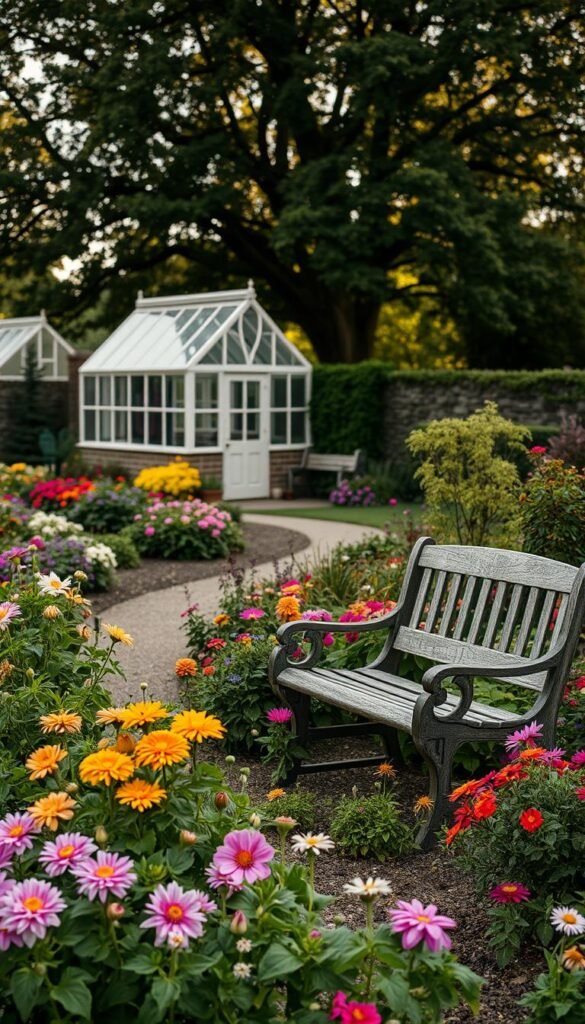
Picture a retreat where every plant tells a story, weaving together hues and textures in a living mosaic. Your outdoor space becomes a canvas where imagination meets practicality—a place where weathered fences support climbing roses and stone pathways invite exploration.
Assess Your Site and Surroundings
Start by studying your landscape like a detective. Note where sunlight lingers longest and where shadows creep in. Is your soil sandy or clay-heavy? These clues determine whether lavender will thrive or ferns might flourish. Existing walls or slopes aren’t obstacles—they’re free design features waiting to showcase trailing ivy or cascading flowers.
Sketch rough zones for seating nooks and meandering paths. Remember: curves feel more inviting than straight lines in this style. If you’re working with limited space, vertical planters or hanging baskets add depth without crowding.
Create a Mood Board for Inspiration
Collect images of crumbling terracotta pots, overflowing flower beds, and repurposed treasures that spark joy. Do pastel peonies make your heart sing, or do you prefer the wild energy of sunflowers? Your mood board helps refine your vision before you dig the first hole.
Match plant choices to your home’s architecture. A farmhouse might pair with hollyhocks and daisies, while a modern cottage could blend sculptural grasses with fragrant herbs. This harmony makes your garden feel like it’s always belonged there.
Understanding the DNA of Cottage Gardens
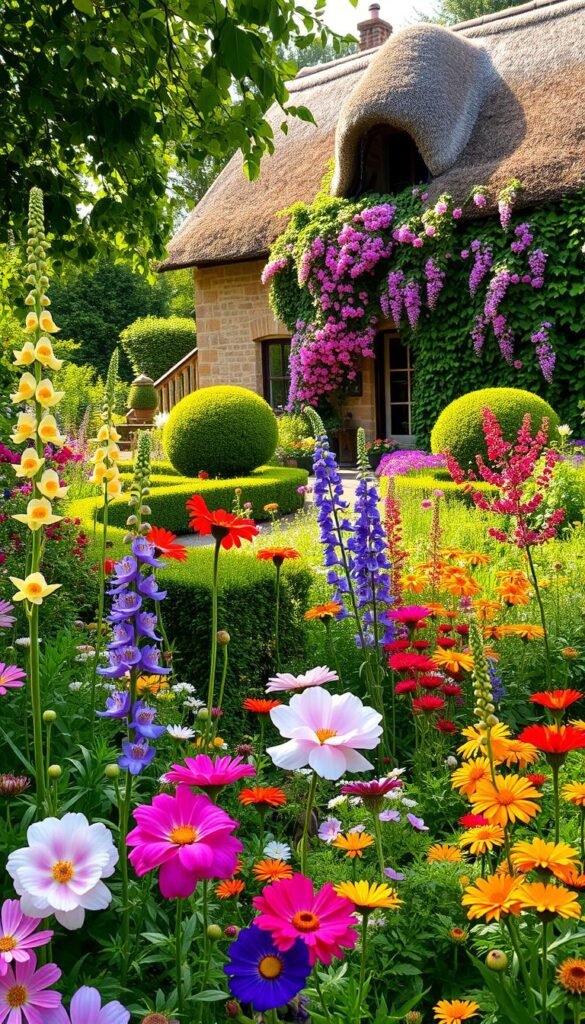
At the heart of every thriving cottage garden lies a story of practicality meeting poetry. Historically, these spaces weren’t just pretty—they fed families, provided medicine, and attracted pollinators. Each plant earned its spot by being beautiful, useful, or edible, often all three. This blend of purpose and charm defines the traditional cottage garden spirit.
Focus on cottage garden plants that work overtime. Roses offer fragrant blooms and rosehip tea potential. Lavender repels pests while calming your senses. Tall spires of lupins and foxgloves draw the eye upward, creating living architecture. These classics thrive with minimal fuss, echoing the self-sufficient nature of early designs.
The magic happens when shapes and scents collide. Delicate cosmos dance beside spiky hollyhocks, while velvety sage leaves contrast with feathery ferns. This mix looks wild but follows nature’s playbook—early bloomers make space for late-season stars. As one gardener noted, “The best designs let plants write their own verses in the garden’s poem.”
Modern cottage gardens keep this DNA alive by choosing resilient varieties. Opt for self-seeding flowers like calendula or poppies that pop up year after year. Pair them with herbs like thyme, which sprawls attractively over paths. This approach reduces upkeep while maximizing color and fragrance from spring through fall.
Want to deepen the cottagecore aesthetic? Let edible nasturtiums cascade from baskets or train beans up rustic obelisks. By blending form and function, you’ll create a space that’s both enchanting and enduring—true to its roots yet freshly yours.
Small Cottage Garden Ideas to Create a Quaint and Charming Look
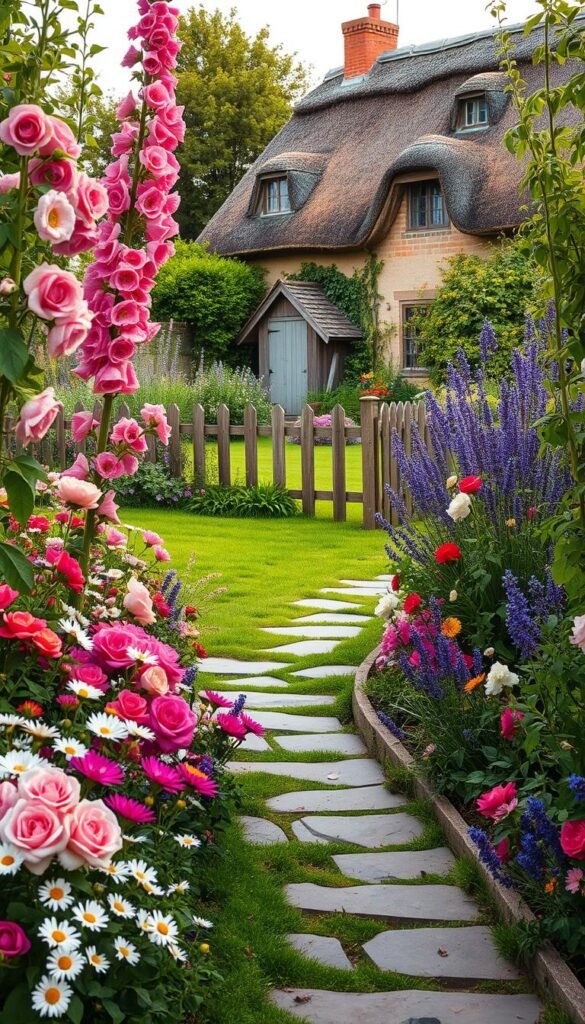
Visualize a tapestry of blooms where every inch tells a story of color and life. This maximalist approach transforms limited areas into lush retreats bursting with personality. Take cues from expert growers who pack vertical and horizontal spaces with diverse plants—delphiniums reaching skyward while creeping thyme softens walkway edges.
Layering becomes your secret weapon. Start with tall spires like foxgloves as living backdrops. Fill mid-level gaps with mounding salvias and peonies, then let trailing lobelia spill from containers. This tiered arrangement tricks the eye into perceiving depth, making your plot feel larger than its footprint.
| Layer | Height Range | Role | Plant Examples |
|---|---|---|---|
| Backdrop | 4-6 feet | Vertical interest | Delphiniums, Foxgloves |
| Mid-Level | 2-3 feet | Color bursts | Peonies, Salvias |
| Front Row | Under 1 foot | Edging & texture | Thyme, Sweet Alyssa |
Mix plant forms for dynamic energy. Pair spiky lupines with round hydrangea blooms, then add airy cosmos for contrast. Self-seeding annuals like calendula fill bare spots naturally, reducing maintenance while enhancing that effortless charm.
Dual-purpose picks multiply your rewards. Strawberry plants offer scarlet fruits and groundcover greenery. Purple basil delivers aromatic leaves and striking foliage. These multitaskers prove beauty and practicality thrive together in thoughtfully designed spaces.
Let Nature Lead Your Gardening Journey
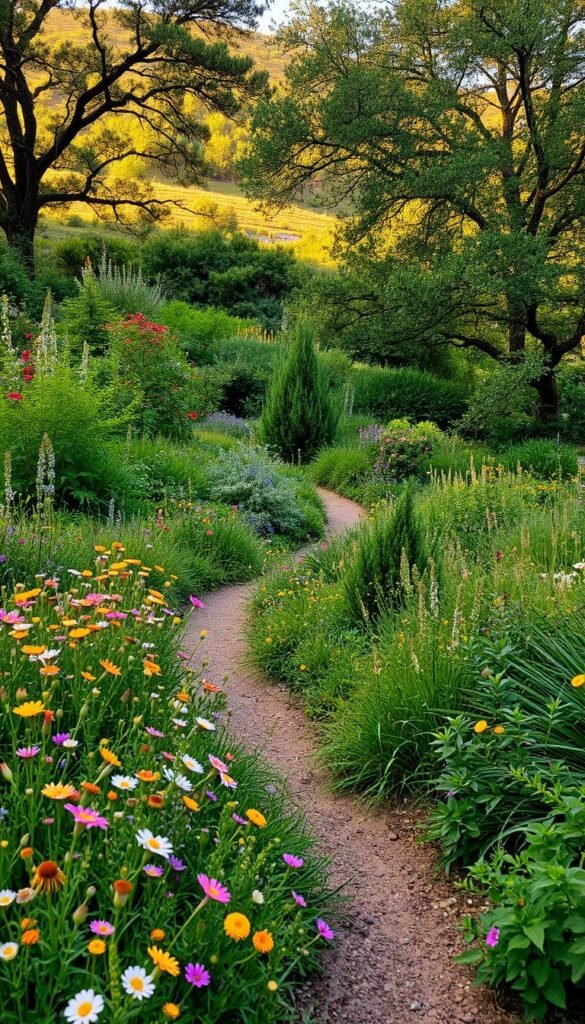
Envision a garden where plants dance freely, their roots weaving stories into the earth. This approach celebrates nature’s wisdom, inviting spontaneity while nurturing biodiversity. By working with ecological patterns rather than against them, you’ll craft spaces that feel alive in every season.
Incorporate Natural Planting Methods
Ground cover becomes your ally in softening edges and suppressing weeds. Creeping thyme spills over pathways, while snow-in-summer blankets shady corners with silvery foliage. These living carpets eliminate bare soil, creating seamless transitions between plants and hardscapes.
| Aspect | Natural Approach | Controlled Approach |
|---|---|---|
| Ground Cover | Self-spreading thyme & germander | Mulch or landscape fabric |
| Plant Selection | Self-seeding annuals | Pre-planned arrangements |
| Maintenance | Seasonal adjustments | Weekly interventions |
Embrace Self-Seeding and Organic Growth
Let foxgloves and poppies scatter their seeds like confetti. These surprise volunteers create shifting patterns of color, ensuring no two years look identical. Native species like coneflowers will mingle with cultivated blooms, fostering resilience through diversity.
Allow sheltered corners to grow wilder, where beneficial insects thrive among unmown grasses. As one gardener shared, “My best designs happen when I’m not looking—nature plants what the land needs.” This balance reduces upkeep while deepening your garden’s connection to local ecosystems.
Mixing Edible and Ornamental Plants Creatively
Picture plump strawberries nestled beside fragrant roses—a pairing where beauty meets bounty. This is the magic of blending edible and decorative plants in your cottage garden. Designer Tim Pilgrim proves even compact spaces can burst with life when vegetables mingle with flowers. Imagine ruby-hued rainbow chard leaves contrasting with velvety sage, or purple kale framing a cascade of nasturtiums.
Your herb selections become living art. Choose lavender for its silvery foliage and calming scent, or pineapple sage for fiery blooms that hummingbirds adore. Thyme spills over stone edges, while basil’s glossy leaves add texture to flower beds. These multitaskers offer fresh flavors and pollinator appeal.
Maximize vertical space with climbers. Let sugar snap peas scramble up obelisks beside sweet peas, blending harvests with blossoms. Scarlet runner beans create living curtains of red flowers—edible and eye-catching. Even dwarf apple trees work as focal points, their spring blooms preceding autumn fruit.
For timeless charm, pair roses with garlic chives. Their spiky leaves complement soft petals while deterring pests. Underplant berry bushes with violas, or tuck parsley between daylilies. As Pilgrim notes, “When every plant serves two purposes, your garden becomes both pantry and paradise.”
Prioritizing Texture, Colors, and Fragrance
Envision a painter’s palette brought to life through petals and foliage. Your cottage garden becomes a living canvas when you balance hues, scents, and tactile elements. Start with a foundation of soft pinks and mauves—think billowy peonies paired with airy lavender spires. These tones create harmony while allowing purple accents to pop like exclamation points.
Fragrance transforms your space into a sensory journey. Plant old-fashioned roses near benches where their perfume lingers. Line pathways with sweet peas or jasmine—their evening scent intensifies as stars emerge. For year-round appeal, mix early-blooming lilacs with late-season honeysuckle.
| Texture Type | Visual Impact | Plant Examples |
|---|---|---|
| Feathery | Adds movement | Maiden grass, Astilbe |
| Velvety | Softens edges | Lamb’s ear, Sage |
| Spiky | Creates contrast | Sea holly, Lupines |
Introduce drama through strategic color bursts. Plant Verbena bonariensis among cream-colored Shasta daisies—their purple crowns attract butterflies while complementing pastel schemes. For container accents, pair silver-leafed artemisia with vivid catmint blooms.
Layer bloom shapes to build depth. Flat yarrow clusters contrast with spherical alliums, while clematis vines weave vertical ribbons of color. As one designer notes, “The magic happens when rough meets delicate—like hydrangeas brushing against spiky grasses.” This interplay keeps eyes dancing across your garden’s ever-changing tapestry.
Cultivating Climbing Plants and Vertical Interest
Transform your outdoor space into a vertical wonderland where blooms reach for the sky. Climbing plants add dimension and romance, turning blank walls into living art or creating shaded retreats under floral arches. Their upward growth maximizes limited areas while infusing air with sweet scents like jasmine’s evening perfume.
Choose the Right Climbing Varieties
Roses steal the spotlight with their timeless charm, but pair them with clematis for staggered blooms. Honeysuckle attracts hummingbirds, while star jasmine offers evergreen foliage. For bold drama, wisteria’s cascading purple clusters create instant fairy-tale vibes. Match varieties to your climate—passionflower thrives in warmth, while climbing hydrangea prefers shade.
Create Arbors and Trellises for Support
Sturdy structures guide growth while adding architectural flair. Repurpose old ladders as rustic frames or install curved metal obelisks among perennials. DIY trellis designs using weathered wood blend seamlessly into cottage garden aesthetics. Train rambling roses over arbors to frame pathways, or let sweet peas scramble up twig towers for whimsical height.
Vertical layers aren’t just space-savers—they create microhabitats for butterflies and bees. As vines weave through supports, your garden gains depth and mystery, proving that looking up often reveals the most enchanting views.

